Winter in Chinese culture is often regarded as a season of reflection and renewal, embodying a unique beauty that resonates deeply within the hearts of many. The cold, crisp air and the serene landscapes create an atmosphere that encourages introspection and appreciation for the natural world. In traditional Chinese philosophy, winter is associated with the element of water, symbolising wisdom and adaptability.
This season is not merely a time of dormancy; rather, it is a period where nature prepares for the rebirth of spring. The stark beauty of snow-covered mountains and frozen rivers serves as a reminder of the cyclical nature of life, where every ending paves the way for new beginnings. Moreover, winter is celebrated for its quietude and stillness, offering a stark contrast to the vibrancy of other seasons.
The sight of snowflakes gently falling from the sky evokes a sense of peace and tranquillity, inviting individuals to slow down and appreciate the moment. In Chinese literature and art, winter is often depicted as a time for contemplation, where the beauty of simplicity reigns supreme. The imagery of bare trees against a backdrop of white snow captures the essence of resilience and strength, reflecting the enduring spirit of both nature and humanity. Spaces are filling up fast! Register your child for Chinese Winter Camp at the LC Chinese School in Oslo today.
Table of Contents
ToggleSummary
- Winter is celebrated as a time of beauty and tranquility in Chinese culture, with a focus on the serene landscapes and peaceful atmosphere.
- Traditional winter festivals in China, such as the Spring Festival and Lantern Festival, are marked by colourful parades, fireworks, and family gatherings.
- Popular winter activities and sports in China include ice skating, skiing, and snowboarding, with many resorts and outdoor rinks available for enthusiasts.
- Winter cuisine in China features warming dishes such as hot pot, dumplings, and steamed buns, as well as traditional Chinese teas to keep warm.
- Traditional winter fashion in China includes thick, padded coats, fur-lined hats, and embroidered scarves, reflecting the country’s rich cultural heritage.
Traditional Winter Festivals and Celebrations in China
One of the most significant winter festivals in China is the Winter Solstice Festival, known as Dongzhi. This celebration marks the longest night of the year and has been observed for centuries. Families come together to honour their ancestors and enjoy traditional foods that symbolise reunion and harmony.
Tangyuan, glutinous rice balls filled with sweet or savoury fillings, are often served during this festival, representing unity and completeness. The act of making and sharing these delicacies fosters a sense of togetherness, reinforcing familial bonds during this cold season. Another important celebration is the Chinese New Year, which typically falls in late January or early February.
This festival marks the beginning of a new lunar year and is steeped in rich traditions and customs. Families engage in thorough cleaning of their homes to sweep away bad luck and make way for good fortune. The streets come alive with vibrant decorations, lion dances, and fireworks, creating an atmosphere of joy and excitement.
The reunion dinner on New Year’s Eve is a highlight, where families gather to share a lavish meal that includes symbolic dishes meant to bring prosperity and happiness in the coming year.
Winter Activities and Sports in China

As winter blankets much of China in snow, various activities and sports emerge that celebrate the season’s unique offerings. Skiing has gained immense popularity in recent years, particularly in regions like Harbin and Yanqing, where world-class ski resorts have been developed. These resorts attract both locals and tourists eager to experience the thrill of gliding down snow-covered slopes amidst breathtaking mountain scenery.
Skiing not only provides an exhilarating escape from daily life but also fosters a sense of camaraderie among participants who share a passion for winter sports. In addition to skiing, ice skating is another beloved winter pastime in China. Cities like Harbin host grand ice festivals where massive ice sculptures are displayed alongside frozen lakes transformed into skating rinks.
Families flock to these venues to enjoy skating together, creating cherished memories against a backdrop of stunning artistry. The combination of physical activity and artistic expression encapsulates the spirit of winter in China, showcasing how this season can be both invigorating and enchanting.
Winter Cuisine and Traditional Chinese Food
Winter cuisine in China is characterised by hearty dishes that provide warmth and nourishment during the colder months. One staple is hot pot, a communal dining experience where diners cook various ingredients in a simmering pot of broth at their table. This interactive meal not only warms the body but also fosters social connections as families and friends gather around to share food and stories.
The variety of ingredients used in hot pot reflects regional diversity, with each area boasting its own unique flavours and styles. Another beloved winter dish is lamb stew, particularly popular in northern regions where temperatures can plummet. The rich, aromatic flavours of slow-cooked lamb combined with root vegetables create a comforting meal that warms both body and soul.
Additionally, dumplings are often prepared during winter festivals, symbolising wealth and prosperity. Families come together to make these delicious morsels, filling them with various ingredients that reflect their cultural heritage. The act of making dumplings becomes a cherished tradition that strengthens familial ties while celebrating the joys of winter cuisine.
Winter Fashion and Clothing in Chinese Culture
Winter fashion in China reflects both practicality and elegance, with traditional garments designed to provide warmth while showcasing cultural heritage. One iconic piece is the Tang suit, characterised by its high collar and intricate embroidery. Often worn during festive occasions, this attire embodies the spirit of celebration while keeping wearers warm during chilly winter nights.
The use of rich fabrics such as silk and brocade adds an element of luxury to winter wardrobes, allowing individuals to express their personal style while honouring tradition. In contemporary settings, winter fashion has evolved to incorporate modern trends while still paying homage to traditional aesthetics. Layering is key during this season, with stylish coats paired with scarves and hats that not only provide warmth but also enhance overall appearance.
Bright colours and bold patterns are often embraced to counteract the dreariness of winter weather, reflecting a sense of optimism and vibrancy amidst the cold. This blend of tradition and modernity showcases how Chinese culture continues to adapt while preserving its rich heritage.
Winter Landscapes and Scenery in China

The winter landscapes across China are nothing short of breathtaking, offering a visual feast that captivates both locals and visitors alike. From the snow-capped peaks of the Himalayas to the tranquil beauty of frozen lakes in Harbin, each region presents its own unique charm during this season. The contrast between the white snow and the deep blue sky creates a stunning backdrop for outdoor activities such as hiking or photography, inviting individuals to immerse themselves in nature’s splendour.
In addition to natural beauty, urban landscapes transform during winter as cities adorn themselves with festive lights and decorations. The sight of ancient temples surrounded by snow creates a picturesque scene that evokes a sense of nostalgia and reverence for history. Parks become magical wonderlands where families can enjoy sledding or building snowmen, fostering a sense of joy and community amidst the serene surroundings.
These winter landscapes serve as reminders of nature’s artistry while providing spaces for connection and celebration.
Winter Wildlife and Nature in China
Winter also brings forth unique wildlife experiences in China as many animals adapt to the colder climate. In regions like Tibet, one can witness herds of yaks grazing on sparse vegetation while enduring harsh conditions. These resilient creatures embody the spirit of survival amidst adversity, showcasing nature’s ability to thrive even in challenging environments.
Birdwatchers flock to wetlands during winter months to observe migratory birds that seek refuge from colder climates, adding vibrancy to otherwise stark landscapes. Moreover, China’s diverse ecosystems offer opportunities for wildlife enthusiasts to witness rare species such as the snow leopard or giant panda in their natural habitats during winter months. Conservation efforts have been implemented to protect these animals from habitat loss and climate change, highlighting the importance of preserving biodiversity for future generations.
Engaging with winter wildlife not only fosters appreciation for nature but also encourages individuals to take action towards environmental conservation.
Winter Traditions and Customs in Chinese Families
Within Chinese families, winter traditions are deeply rooted in cultural practices that emphasise togetherness and gratitude. One such custom is the practice of ancestor worship during the Winter Solstice Festival, where families pay homage to their forebears by preparing special offerings at ancestral altars. This act serves as a reminder of familial connections that transcend generations, reinforcing values such as respect and gratitude within households.
Additionally, many families engage in activities such as making handmade decorations or preparing traditional foods together during winter festivals. These shared experiences create lasting memories while instilling cultural values in younger generations. The emphasis on family unity during this season highlights the importance placed on relationships within Chinese culture, fostering bonds that endure beyond seasonal celebrations.
Winter Poetry and Literature in Chinese Language
Winter has long been a source of inspiration for poets and writers throughout Chinese history, with countless works capturing its essence through vivid imagery and profound reflections. Classical poetry often portrays winter as a time for contemplation, where themes of solitude and introspection take centre stage. Poets like Li Bai and Du Fu have penned verses that evoke feelings of nostalgia while celebrating nature’s beauty during this season.
In contemporary literature, winter continues to serve as a backdrop for exploring human emotions and experiences. Novels set against snowy landscapes often delve into themes of love, loss, and resilience, reflecting how individuals navigate life’s challenges amidst harsh conditions. This literary tradition underscores how winter serves not only as a physical season but also as a metaphorical landscape for personal growth and transformation.
Winter Art and Crafts in Chinese Culture
Artistic expression flourishes during winter months in China as artisans create works inspired by seasonal themes. Traditional crafts such as paper-cutting often feature motifs related to winter festivities—snowflakes, lanterns, or animals associated with good fortune are commonly depicted. These intricate designs are not only visually stunning but also carry cultural significance, symbolising hope and prosperity for the coming year.
Moreover, calligraphy takes on new meaning during this season as artists create pieces that reflect their thoughts on winter’s beauty or convey wishes for health and happiness during festive celebrations. The act of creating art becomes a meditative practice that allows individuals to connect with their cultural heritage while expressing their personal sentiments about this enchanting season.
Winter Music and Festive Celebrations in China
Music plays an integral role in winter celebrations across China, with traditional melodies resonating through homes during festive gatherings. Instruments such as the erhu or guzheng are often played to evoke feelings of nostalgia while enhancing the celebratory atmosphere. During events like the Chinese New Year or Winter Solstice Festival, families come together to sing songs that convey wishes for prosperity and happiness in the coming year.
Festive celebrations are marked by lively performances featuring traditional dances accompanied by music that reflects regional cultures throughout China. Lion dances performed during New Year festivities are particularly popular; they symbolise good luck while captivating audiences with their vibrant movements and rhythmic beats. These musical expressions not only entertain but also serve as reminders of cultural heritage—uniting communities through shared experiences rooted in tradition.
In conclusion, winter holds a special place within Chinese culture—a season rich with beauty, traditions, culinary delights, artistic expression, familial connections, literary inspiration, wildlife encounters, fashion statements, festive celebrations—and so much more! As we embrace this enchanting time each year we are reminded not only about nature’s cycles but also about our own connections with one another through shared experiences rooted deeply within our cultural heritage!







